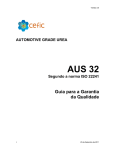Download MAIN ECONOMIC INDICATORS CD
Transcript
OECD MAIN ECONOMIC INDICATORS CD-ROM USER GUIDE MEI on BEYOND 20/20 Other sources of information on OECD data: The OECD web site contains other information on OECD data, see www.oecd.org. For the Main Economic Indicators, the metadata, database notes, and technical documentation pertaining to Member countries are also available on www.oecd.org/std/mei. This site also gives access to the OECD sources and methods publications. For Non-member countries, data and metadata are available on www.oecd.org/statistics/nm-countries. Information on the OECD leading indicators is available at www.oecd.org/std/cli. Contact: OECD Electronic Publications 2, rue André Pascal 75775 Paris Cedex 16 France Fax: (33-1) 49-10-42-76 E-mail: [email protected] MAIN ECONOMIC INDICATORS -- USER GUIDE TABLE OF CONTENTS 1. INTRODUCTION 4 2. DESCRIPTION OF MEI ON BEYOND 20/20 5 3. MEI ON BEYOND 20/20 COMPARED WITH THE PAPER PUBLICATION 7 4. CONTENTS OF THE CD-ROM 8 4.1 The Countries and Area Totals (see also Appendix A) 8 4.2 The Data 10 4.3 The Metadata 12 5. EXPORTING MEI DATA 13 6. DESCRIPTION OF THE OECD CSV FILE FORMAT 13 6.1. Record structure of the file 13 6.2. Examples of record 14 6.3 14 Support APPENDIX A: ISO AND AREA TOTAL CODES 15 APPENDIX B: AREA TOTALS 16 APPENDIX C: MONETARY UNITS 17 APPENDIX D: EXPLANATION OF MEASURES 18 3 1. Introduction The Main Economic Indicators database presents a range of comparative short-term economic indicators that provide an overview of recent international economic developments. It is an indispensable source of statistics for analysis by corporate planners, economists, academics, and researchers, as well as students, in a variety of fields. Monthly, quarterly and annual data are available for 30 OECD Member countries, and a number of non-member countries including Brazil, China, Indonesia and Russian Federation. Indicators are also presented for a number of OECD country groupings including official statistics for the euro area. Many series for OECD countries are available back to 1960 and back as far as possible, at least to the early 1990s for non-members. The database is updated monthly. For all countries the indicators cover the main aggregates of quarterly national accounts, indices of production, commodity output, domestic demand, business tendency and consumer confidence survey results, stocks, orders and deliveries in the manufacturing industry, construction, consumer and producer prices, domestic and external finance, labour market, wages, foreign trade and balance of payments. For OECD countries considerably more information is available on balance of payments statistics, business survey results and composite leading indicators. For the majority of OECD countries, balance of payments statistics are compiled in accordance with the methodology of the 5th edition of the Balance of Payments Manual published by the IMF (BPM5), and presented according to the Standard Presentation. They cover credit, debit and balances of the current account; income, services, trade in goods, current transfers, in both seasonally adjusted and unadjusted forms plus many details for the financial accounts which are presented only in a seasonally unadjusted form. Results from business tendency surveys reflect business managers’ perceptions of current and future developments of important business indicators. They form an important part of the OECD composite leading indicators, which facilitate early detection of turning points of economic activity. The following variables are available for country groupings: quarterly national accounts by category of expenditure, GDP volume index, industrial production, composite leading indicators, passenger car registrations, volume of retail sales, producer prices, consumer prices, hourly earnings in manufacturing, standardised unemployment rates, civilian employment, international trade, world trade (country groupings given are world, OECD-Total, non-OECD), narrow and broad money. Data are available in both the Beyond 20/20 software and in csv format. The CDROM also contains an HTML file (MetaCtr.htm) of extensive statistical methodological information on current national practices for the compilation of the indicators. In order to assist cross-country comparisons this information is presented in a structured format under the headings: definition, coverage, calculation, collection and source. Information is made available about revisions, additions and suppressions to data series, and about other modifications to the database (see the file Meinotes.txt). This guide presents a summary of the organisation and contents of this electronic product. 4 2. Description of MEI on Beyond 20/20 The data in the Beyond 20/20 software are presented in a 2-dimensional table. The two dimensions of the table are variables by country and time. On opening the tables a list of countries appears. On opening the countries the variables (series) for each country or zone are presented vertically with time shown across the page. The table may be transposed easily for different presentations. The CD-ROM covers data from 1960 when available of monthly, quarterly and annual data. It is possible to select all variables for any one country or area total or alternatively to select all countries for a particular variable using the search function. It should be noted that not all variables exist for all countries. 2.1 Description of table fields The descriptive fields which can be selected for viewing by clicking on the “Next label" icon along with the data are: Series title: short title for the time series. Series Code: a string composed of up to 19 characters made up of a country code, subject code and measure code. Country code: characters 1 to 3 refer to the ISO country code or area total abbreviation (see Appendix A). Subject code: characters 4 to 11: are made up of four 2-character abbreviations of the four level subject hierarchy (the main headings referring to the first level of the subject hierarchy are shown under Section 4.2). It is possible to view the headings of all the levels of the hierarchy on Beyond 20/20. Click on View followed by Dimension and under column Subject_Name_E the four headings are listed separated by the divider "/". For example, for the subject code NAGVTT01, the subject name would be - National Accounts/GDP by Expenditure (constant prices)/Total GDP/Total. A more detailed listing of the two character abbreviations and the hierarchy can be found at the Internet address http://www.oecd.org/std/mei under MEI Hierarchy. The listing is a complete representation of all series subject codes but should not be taken to suggest that all series are available for all countries. 5 Measure code: characters 12 up to 18. A measure describes the way data are presented. For example IXOB signifies that data are expressed as an index in base year 1995. QL series are expressed as quarterly levels. SA at the end of the measure code signifies that the data are seasonally adjusted. A list of possible measures are given in Annex C. Country or Area total name Subject hierarchy: a string containing the position of the time series in the logical organisation of subjects (four levels). See above item subject code for more details. Old series codes: the code is no longer used. The field remains empty. Unit: unit in which the series is expressed in the printed publication and on the ivt file. When data are exported from Beyond 20/20 they should be multiplied by the corresponding power of ten (see next item). As a result of the multiplication, indices will be expressed in base = 1.00 (and not base = 100) and exchange rates will be expressed in Dollars per unit of national currency (and not Cents per unit of national currency) to facilitate the use of the data in further calculations. The power of ten (see next item) associated with indices is -2. Applying the power of ten to the indices will transform them into indices with base year =1. Power of ten: the number 3 signifies that the data in the printed publication and on the ivt file are expressed in thousands, 6 means that the data are in millions, 9 in billions etc. The number is the power of ten needed to multiply the figures to obtain the data in units. See item above for the particular case of indices. 6 3. MEI on Beyond 20/20 Compared with the Paper Publication MEI on Beyond 20/20 CD-ROM contains all of the economic indicators in Parts One, Two and Three of the paper publication plus a wide range of information from business tendency surveys, additional composite leading indicators and their components, and details of balance of payments. Monthly, quarterly, and annual data on the MEI on Beyond 20/20 CD-ROM go back to 1960 for many series of OECD countries. For Non-member countries, data go back at least to the early 1990s. The tables in the paper publication show a maximum of 12 months, 9 quarters, and 4 years. The MEI on Beyond 20/20 CD-ROM contains an HTML file of metadata for all countries, such as sources and definitions, for the majority of the series. Much of this information does not appear in the paper publication. A separate bi-annual supplement, Main Economic Indicators: Sources and Definitions is available to complement the monthly publication. Additional publications are being prepared which will provide comparisons of methodologies used to compile short-term economic indicators published by the OECD for Member and Non-member countries. Updates to the metadata are made available each month on CD-ROM and at the following location on Internet: http://www.oecd.org/std/meta (see National methodological practices). A web browser is required to read the HTML file. 7 4. Contents of the CD-ROM The data are given for the 30 OECD Member countries, for several groups of countries, and for a number of Non-member countries (more Non-member countries will be added during the course of 2002). This chapter describes: • the countries and area totals • the data • the metadata 4.1 The Countries and Area Totals (see also Appendix A) The OECD Member countries are: Canada, Mexico, United States, Australia, Japan, Korea, New Zealand, Austria, Belgium, Czech Republic, Denmark, Finland, France, Germany, Greece, Hungary, Iceland, Ireland, Italy, Luxembourg, Netherlands, Norway, Poland, Portugal, Slovak Republic, Spain, Sweden, Switzerland, Turkey, and United Kingdom. This is the order of the countries as they appear in MEI on Beyond 20/20. That is, alphabetical order by continent for North America, Asia/Oceania, Europe and Non-member countries. Certain variables are shown for a number of area totals when data availability permit. Data for Slovak Republic will be added to the appropriate zones during the course of 2001. The main area totals are: OECD-Total: Canada, Mexico, United States, Japan, Korea, Australia, New Zealand, Austria, Belgium, Czech Republic, Denmark, Finland, France, Germany, Greece, Hungary, Iceland, Ireland, Italy, Luxembourg, Netherlands, Norway, Poland, Portugal, Slovak Republic, Spain, Sweden, Switzerland, Turkey, and United Kingdom. OECD-Total (Former): Canada, Mexico, United States, Japan, Australia, New Zealand, Austria, Belgium, Denmark, Finland, France, Germany, Greece, Iceland, Ireland, Italy, Luxembourg, Netherlands, Norway, Portugal, Spain, Sweden, Switzerland, Turkey, and United Kingdom. 8 EU15 (countries of the European Union): Austria, Belgium, Denmark, Finland, France, Germany, Greece, Ireland, Italy, Luxembourg, Netherlands, Portugal, Spain, Sweden, and United Kingdom. Euro area (countries of the European Monetary Union): Austria, Belgium, Finland, France, Germany, Greece, Ireland, Italy, Luxembourg, Netherlands, Portugal, and Spain. OECD-Europe (all European Members of OECD): Equals EU15 plus Czech Republic, Hungary, Iceland, Norway, Poland, Slovak Republic, Switzerland and Turkey. OECD-Europe (Former): Equals EU15 plus Iceland, Norway, Switzerland and Turkey. Major Seven (the group of seven most industrialised nations): Canada, France, Germany, Italy, Japan, United Kingdom, and United States. Non-member countries: Brazil, Bulgaria, China, Estonia, Indonesia, Latvia, Lithuania, Romania, Russian Federation, Slovenia, South Africa and Ukraine. It should be noted that two codes are used in the database for the Euro area; the code EMU is used to refer to statistics supplied by the European Central Bank (ECB) or the Statistical Office of the European Communities (Eurostat) and the code EUZ is used for series compiled according to the prevailing MEI methodologies for zone aggregation. Greece joined the Euro area as a 12th Member state from January 2001. Metadata should be consulted in order to ascertain the exact composition of countries included in EMU and EUZ for each variable over time. 9 4.2 The Data The data consist of time series showing the evolution of important shortterm economic indicators for OECD Member countries and for Nonmember countries. The data cover from 1960, when available for OECD countries and from at least the early 1990s for Non-member countries. The periodicities of the data are monthly, quarterly, and annual, subject to availability (note that only a small percentage of the data is annual). The data are organised according to a standard subject classification under the main headings listed below. These are similar, but not identical, to the subject headings of the paper publication. The names of all levels of the hierarchy are given in full in both the Beyond 20/20 and csv formats in the description field along with the data. All series which appear in Part 1 Indicators by Subject of the paper publication can be found in MEI on Beyond 20/20 under the appropriate subject heading. The main subject headings included are: LO - Leading indicators NA - National accounts PR - Production BS - Business tendency surveys CS - Consumer opinion surveys MN - Manufacturing (deliveries, stocks and orders) CN – Construction DD – Domestic demand EM - Employment UN - Unemployment OL - Other labour market indicators LC - Labour compensation PP - Producer prices WP - Wholesale prices CP - Consumer prices OP - Other prices MA - Monetary aggregates and their components DC - Domestic credit and debt IR - Interest rates SI - Security issues SP - Share prices CC - Currency conversions XF - External finance IT - International trade BP - Balance of payments 10 The following variables are available for area totals: Quarterly national accounts by category of expenditure * GDP volume index Industrial production Composite leading indicators Industrial production Passenger car registrations Retail sales (volume index) Producer prices Consumer prices Hourly earnings Standardised unemployment rates Civilian employment International trade World trade (area totals given are World, OECD-Total, non-OECD) Narrow money Broad money Apart from Quarterly national accounts, GDP volume index and World trade variables only those countries for which data are available are included in the relevant area total. * More detailed information on quarterly national accounts is available in the specialised OECD publication Quarterly National Accounts for OECD Member countries. Refer to the printed version of this publication for additional data and metadata. For historical GDP data at current prices of euro area countries, aggregation methods used by the OECD differ from those used by Eurostat. To preserve consistency across OECD publications, pre-1999 data as computed by Eurostat are not shown here anymore. A detailed description of the OECD approach can be found in the article by Schreyer and Suyker in the forthcoming Statistics Brief Number 2, February 2002 published by the Statistics Directorate of OECD. 11 4.3 The Metadata A wide variety of metadata is included in the form of an HTML file. You will need an Internet browser to view the metadata on-screen. The metadata are organised by country and subject areas. Subject areas are according to the monthly printed publication Main Economic Indicators. Metadata for the following items are provided where applicable, relevant, or available: definition: Gives more information about the concept covered by the series. coverage: This can refer to geographic coverage, classification coverage or the population covered by the indicator. For example: the CPI for the United States is based on observations from urban areas only. collection: Describes the procedures used to gather the data. For example: sample survey of 20 000 households. calculation: Gives information on the calculation methods used. For example: the index number presented is of the Laspeyres type. 12 5. Exporting MEI Data Files can be exported from Beyond 20/20 as CSV, WKS, WK1, dBASE, TEXT and AREMOS TSD. 6. Description of the OECD csv file format The csv file format version of Main Economic Indicators is an ASCII comma separated values (csv) format. It has been designed for easy bulk data transfer of OECD data files onto a database system. 6.1. Record structure of the file The first record gives the list of fields in the correct order. The other records contain the time series, one per record, with the attributes and data as presented in the first record and separated by commas. In case the data or the attribute is not available there is nothing between the corresponding commas. The fields used to store the time series which are presented in the first record of the file are: series code, old series code, country, subject hierarchy, title, power of ten, unit, then data, control code, from 1960 to present, first the years, then the quarters and then the months. The content of the fields is the following: • Series code: a string composed of a country code, a subject code and a measure code (see earlier description in Section 2.1). • Old series code: no longer used. The field remains empty. • Country: the name of the corresponding country or area total. • Subject hierarchy: a string containing the position of the time series in the logical organisation of subjects (four levels) (see earlier description in Section 2.1). • Title: a string containing the English title of the time-series. • Power of ten: the number 3 signifies that the data in the printed publication are expressed in thousands, 6 means that the data are in millions, 9 in billions etc. The number is the power of ten needed to multiply the figures to obtain the data in units. See item below for the particular case of indices. • Unit: unit in which the series is expressed in the printed publication. When data are exported from the csv file they should be multiplied by the corresponding power of ten (see next item). As a result of the multiplication, indices will be expressed in base = 1.00 (and not base = 100) and exchange rates will be expressed in Dollars per unit of national currency (and not Cents per unit of national currency) to facilitate the use of the data in further 13 calculations. The power of ten (see item above) associated with indices is -2. Applying the power of ten to the indices will transform them into indices with base year =1. • Data and control codes: value and qualifier. Values are expressed in the corresponding unit. In general there is no qualifier. The permitted qualifiers are: P and E for estimated values, R for breaks in the series and U indicates data are not available. 6.2. Examples of record The following is an example of a first record: "Series code", "A16 code", "country", "subject hierarchy", "Series title", "power of ten", "unit", "1960", control code", “1961", “control code", "1962", "control code", "1963", "control code", "1964", "control code", "1965", "control code", "1966", "control code", "1967", "control code", "1968", "control code", "1969", "control code", "1970", "control code", "1971", "control code", "1972", "control code", "1973", "control code", "1974", "control code", "1975", "control code", "1976", "control code", "1977", "control code", "1978", "control code", "1979", "control code", "1980", "control … etc. The following is an example of a time series record corresponding to that description: "AUS.BPBLIN01.NCCUSA", " ", "AUSTRALIA", "Balance of Payments/Current Account Balance/Income/Total", "AUS BOP NET INCOME SA", 6, "$A", -247, "", -249, "", -240, "", -295, "", -279, "", -307, "", -304, "", -405, "", -492, "", -523, "", -612, "", -605, "", -567, "", -687, "", -654, "", -954, "", -1316, "", -1467, "", -1681, "", -2193, "", -2370, "", -2499, "", -2488, "", -3627, "", -4807, "", -6653, "", -7544, "", -8569, "", -10872, "", -13625, "", -16987, "", -15870, "", -13890, "", -11971, "", -17110, "", -19476, "", -19317, "", -20034, "",, "", -59, "", -66, "", -61, "", -61, "", -74, "", -64, "", -45, "", -66, "", -49, "", -56, "", -60, "", -75, "", -83, "", -64, "", -80, "", -68, "", -59, "", -90, "", -61, "", -69, "", -72, "", -78, "", -83, "", -74, "", -77, "", -73, "", -82, "", -72, "", -79, "", -98, "", -100, "", -128, "", -106, "", -128, "", -127, "", -131, "", -117, "", -138, "", etc. 6.3 Support If you have any question regarding the data or the format for OECD member countries please do not hesitate to write to [email protected]. For Non members countries, please do not hesitate to write to [email protected]. 14 Appendix A: ISO and area total codes COUNTRY Australia Austria Belgium Canada Czech Republic Denmark Finland France Germany Greece Hungary Iceland Ireland Italy Japan Korea Luxembourg Mexico Netherlands New Zealand Norway Poland Portugal Slovak Republic Spain Sweden Switzerland Turkey United Kingdom United States Brazil Bulgaria China Estonia Indonesia Latvia Lithuania Romania Russian Federation Slovenia South Africa Ukraine CODE AUS AUT BEL CAN CZE DNK FIN FRA DEU GRC HUN ISL IRL ITA JPN KOR LUX MEX NLD NZL NOR POL PRT SVK ESP SWE CHE TUR GBR USA BRA BGR CHN EST IDN LVA LTU ROM RUS SVN ZAF UKR AREA TOTALS OECD-Total OECD-Total (former) OECD-Total excl. high inflation OECD-Total excl. high inflation (former) OECD-Europe OECD-Europe (former) OECD-Europe excl. high inflation OECD-Europe excl. high inflation (former) Major Seven EU15 Euro area (11/12 output European sources) Euro area (OECD zone Methodology) WORLD Non-OECD SDR 15 CODE OTO OTF OTL OTI OEU OEF OEL OEI G7M E15 EMU EUZ WLD NOC SDR Appendix B: Area Totals This table shows the OECD countries that are included in each of the area totals, for which a certain number of variables are available. See Section 5.2 for the list of variables. COUNTRY GROUP COUNTRY Australia Austria Belgium Canada Czech Republic Denmark Finland France Germany Greece Hungary Iceland Ireland Italy Japan Korea Luxembourg Mexico Netherlands New Zealand Norway Poland Portugal Slovak Republic Spain Sweden Switzerland Turkey United Kingdom United States Euro area á á EU15 OECD-Europe á á á á á á á á á á á á á á á á á á á á á á á á á á á á á á á á á á á á á á á á á á á á á á á 16 Major seven á á á á á á á OECD-Total á á á á á á á á á á á á á á á á á á á á á á á á á á á á á á Appendix C: Monetary units Unit Country Canada Mexico - Mexique United States - États-Unis Australia - Australie Japan - Japon Korea - Corée New Zealand - Nouvelle-Zélande Austria - Autriche Belgium - Belgique Czech Republic - République tchèque Denmark - Danemark Finland - Finlande France Germany - Allemagne Greece - Gréce Hungary - Hongrie Iceland - Islande Ireland - Irlande Italy - Italie Luxemburg Netherlands - Pays-Bas Norway - Norvège Poland - Pologne Portugal Slovak Republic - République slovaque Spain - Espagne Sweden - Suède Switerland - Suisse Turkey - Turquie United Kingdom - Royaume-Uni Euro area - Zone euro European currency unit Old monetary unit Can$ MN$ $ $A ¥ W NZ$ S FB CK DKr Fmk FF DM Dr Ft ISK £Ir Lit Lux F f. NKr Zl Esc SKK Ptas SKr FS LT £ euro Ecu Monetary unit on Monetary unit on Beyond 20/20 file csv file CAD MXN USD AUD JPY KRW NZD EUR EUR CZK DKK EUR EUR EUR EUR HUF ISK EUR EUR EUR EUR NOK PLZ EUR SKK EUR SEK CHF TRL GBP EUR XEU CAD MXN USD AUD JPY KRW NZD EUR.99ATS EUR.99BEF CZK DKK EUR.99FIM EUR.99FRF EUR.99DEM EUR.01GRD HUF ISK EUR.99IEP EUR.99ITL EUR.99LUF EUR.99NLG NOK PLZ EUR.99PTE SKK EUR.99ESP SEK CHF TRL GBP EUR XEU From February 2002, the national currencies of the 12 Euro Member countries are expressed in euro. All historical data (i.e. pre 2001 for Greece and pre 1999 for all other euro area countries) are calculated by applying the fixed irrevocable exchange rates. However, pre European Monetary Union euro are notional units and are not always suitable to form area aggregates. For further details see the article by Schreyer and Suyker in the forthcoming Statistics Brief Number 2, February 2002 published by the Statistics Directorate of OECD. Note that, for all Euro area countries, data for periods after accession (i.e. 1999 onwards, 2001 onwards for Greece) are expressed in true euro. 17 The monetary units used in both files (csv and Beyond 20/20) are identical in concept. For technical reasons the units cannot be represented in an identical format. The introduction of the euro and the change in the monetary unit does not effect the series codes. They continue to be expressed as [3 digit ISO country code].[8 digit subject code].[measure]. For example, the Austrian gross domestic product series in 1995 prices is expressed as AUT.NAGVTT01.NCAL. The "NC" prefix of the statistical measure to denote national currency now represent data in euro. Appendix D: Explanation of measures CU ML QL ST CXCU CXML CXQL IXN IXNB IXOB IXPY NCML NCQL NCAL NCCU NCIXOB Sum of component periods (e.g. quarter =sum of three months) Monthly level Quarterly level Stock or Quantum Sum of component periods in US dollars Monthly levels in US dollars Quarterly levels in US dollars Normal =100 Index, national base year Index, publication base year (1995) Index, same period previous year National currency, monthly level National currency, quarterly level National currency, annual level National currency, sum of component periods Index made on national currency series SA at the end of a code signifies that the series is seasonally adjusted. 18


























